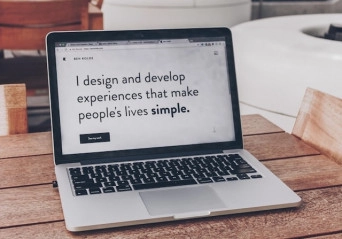If you're running a small business, you're a busy person and it's easy to be lulled into a false sense of confidence that to be successful online you simply need to build a website.
The hard truth is, building a website is just the start if you want to do really well online because then you get into the requirements of running your newly build digital presence. So to help you better understand the ongoing needs of your website and how you may need to plan ahead, we're taking a look at the difference between building and running a website.
Building a Website for Small to Medium-Sized Businesses
For any small or medium sized business, a new website can be a really positive step in competing with other businesses in your space. Perhaps you've not ventured into the online selling space before, maybe you need to provide easier access to information for your customers or maybe your existing website is no longer fit for purpose.
Whatever your reasoning for building a new website, what should you consider during the build phase?
Concept and Planning
Start by being absolutely clear about the goals and objectives that you're seeking to achieve by taking on a website build or rebuild. Are you looking to increase sales, drive more leads and sales opportunities, better engage with potential customers or something else.
Knowing what you want to achieve will help with other elements of the process such as planning website content and the structure of the website pages.
Other considerations you may want to think about are your target audience, how will they access your website, will they be using a mobile device or a laptop for example
Research should also play an important part in this phase, look at your competitors websites, what are and aren't they doing? Are there any features that you could create that they don't have, perhaps you've had feedback from customers about what they want, factor all of this information in and put your customers at the heart of the process.
Design
Website design is a real skill and while website building platforms like Weebly do offer easy to use website builders that anyone can use, we'd always urge any small business to consider investing in the services of a website designer.
Yes, a website designer is a cost, but the design of your website is critical to its future success, if you don't get it right at this stage putting it right later will be a lot of work. Your design needs to be consistent and considerate of what the user needs, think about the actions you want a user to take and make those actions easy.

If you're going to be selling online, think about how you can showcase your products and if you're a service business, consider how you can communicate what you do and how it will benefit your customers.
It's also worth thinking long and hard about any animation or moving elements, things such as spinning images are a distraction and can make you site perform slowly.
Website Technology
While you may not have the experience to specify a server or content management system, knowing and communicating what you want to achieve with a website is important. This will help your team to identify the best website technology for the plans you have, there's no point getting everything created now only to find out that as your sales and website traffic grow, your web server slows down and crashes all the time.
Getting this wrong now will mean the costly exercise of re-platforming later down the line if your website cannot scale effectively.
Development
For SMBs with limited technical expertise, using website builders or content management systems like WordPress or Weebly can streamline the development process. These platforms offer user-friendly interfaces and templates that make it easy to create and customize your website without extensive coding knowledge. Leverage pre-built themes and plugins to add functionality and features to your site efficiently.
There are drawbacks to this approach however as website builders can limit your ability to optimise your site for speed and a fast website is often a website that sells more.
Content Creation
When building a website, small and medium business marketing teams will be working to time pressures and this often means things get overlooked, content is often one of these things.
While it's entirely reasonable to carry content over from an existing website if you have one, be sure to review it all and make sure it's still fit for purpose. Another consideration with content is whether you have any new pages being created in your site build, as these might also need content creating for them.
Creating compelling content is crucial to attract and engage visitors and it can take longer than you think to create content which fits with your brand message. Clear and concise messaging that highlights the unique value proposition of your products or services is essential to help your brand resonate with your potential customers.
It's worth checking out our section on creating great content to help you think more about how to create your content.
Testing
It's so easy to disregard the testing step when building a website, however taking some time to see how your website behaves when you perform common actions is time well spent.
Think about how frustrating it is for you when you visit a website that doesn't work properly, do you want your potential customers to have a similar experience?
Don't just look on your laptop either, if you had a website before, you can see what device types your users use to access your site, use this list to ensure your website works well across those device types.
Check for any broken links, formatting issues, or functionality errors that could detract from the user experience, why not ask for feedback from colleagues or friends to identify any areas for improvement before going live.
Launch
Launching any new website is risky, try to launch your new platform at a time and day when you have the least traffic and sales to reduce impact on your customers. Early morning is often best as fewer people are active online.
When your site is live, make sure to re-test all the key actions, such as making a purchase so you can be sure everything is working as it should be.
Running a Website for Small to Medium-Sized Businesses
Okay, so that's the core plan to create or upgrading your website and you might be asking yourself is maintaining a website really that much more work. Surely once your small business website is online you just leave it to get traffic and reap the rewards.
You can do that but the hard truth is that ongoing maintenance and management are critical for SMBs to maximise the effectiveness and drive business growth through their website.
Below are the key steps to creating that long term growth:
Website Maintenance
If you're unsure what is meant by the term "website maintenance" you can find plenty of help and support in the website maintenance section of our website.
In brief though, you need to check in on your website platform regularly, check if any plugins need updating, are there changes to your theme or security patches? If there are these should be applied as soon as possible.
You might also want to check in on your user tracking to see if certain areas of your website are performing well or need some support.
Content Management
The creation and delivery of fresh content into your website is a great way to bring traffic in and more importantly, keep users engaged. It's important to think about content as more than words though, as we've covered previously, content includes written, image and video content among others.
Don't just focus on new content though, updating historic content is also really important to make sure information remains accurate and relevant. This helps build trust with search engines and real people too.
User Support
Even if you don't want a contact form on your website, make sure you offer (and monitor) communication channels with your customers, whether this is email, phone or socials. If a potential customer has and cannot ask a question, they may just take their purchase elsewhere.
Yes, it can be a real pain to manage, but these are potentially the future lifeblood of your business so spending the time to respond to users is invaluable.
Analytics and Optimisation
Use the data you have available to make informed decisions about what products are selling, which areas of your website people visit most and where they leave. Our GA4 tips and advice section shows you how to set up GA4 tracking and using this user data will help you to make better choices in the future.
Ignoring the data you have available could hand a competitive advantage to your rivals.
Backup Your Website Regularly
Most website platforms and hosting companies provide an option to create back-ups of your website. Where possible make or schedule these regularly as in the event that your website fails, you can use a recent backup to make a new website without losing too much content.
It might not seem important at the time, but getting website backups created could be a real benefit in future.
What's Your View?
So there you have it, the difference between building and running a website should be clear to see. The more effort and time you put into nurturing your digital platform the better returns it should give you.
Of course nothing is guaranteed apart from failing to regularly maintain a website will result in lost sales and revenue.




